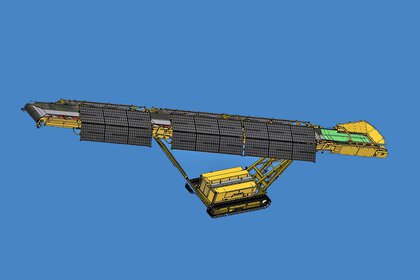Construction machinery efficiency: innovation goes full speed ahead!
bauma 2019 was another incredible event for anyone who continues to be amazed by the ingenuity of engineers and impressive technical solutions. The world’s largest trade fair for the construction industry featured new and exciting construction machinery, building material machines, mining machines, construction vehicles and construction equipment with a special focus on increased efficiency.
When considering efficiency aspects of construction machinery, your mind will naturally focus on energy. Ideally, the workhorses of the construction industry should consume as little energy as possible, which, in the best case scenario, should come from the cleanest energy sources available. The engineers at Keestrack, for example, have managed to consistently meet these requirements. The construction machinery manufacturer based in Munsterbilzen, Belgium, showcased for the first time ever a solar-powered tracked stacker at bauma 2019. Photovoltaic modules span the 23-meter long conveyor belt like a sun sail. They store their energy in the system battery housed in the chassis. The conveyor belt and the caterpillar track are directly electrically driven whilst an electric pump unit supplies the lifting hydraulics.
Obviously, operating a huge piece of equipment such as this using solar power and nothing else is possible only to a certain degree. For example, if the photovoltaic modules fail to supply enough energy due to poor weather conditions or if the power required in intensive continuous operation exceeds the solar-based boost capacity, the system can be powered or recharged by available external sources, such as diesel-electric crushers and screen units, as well as mains electricity.
Managing without any kind of power connection during operations naturally becomes easier the lower the e-machine’s consumption is. A recent example of a self-sufficient electric machine is a battery-powered pressure washer from the manufacturer Kärcher, based in Winnenden, Germany. Two 36-volt lithium-ion rechargeable batteries supply enough power to run the machine for up to 40 minutes in the energy-saving mode. With an operating pressure of 110 bar and a flow rate of up to 400 liters per hour, the cleaning performance of the approximately 35-kg heavy machine reaches the level of mains-powered pressure washers of comparable size.

Energy recovery by the largest material handler of all time
Another approach to increasing energy efficiency is energy recovery. The largest material handler ever built demonstrates this on a large scale. Sennebogen Maschinenfabrik’s gargantuan machine, which will be unveiled at bauma 2019, has an operating weight of approx. 390 tonnes and a range of up to 40 meters. It is equipped with an energy recovery system, which consists of an additional hydraulic cylinder and several gas accumulators. Each time the boom is lowered, the recovered energy is temporarily stored. The next time it is lifted, the energy is available again. This system saves up to 30% energy compared to conventional drives.
Effective transportation of wind turbine blades
However, the economical use of energy is not the only way to achieve efficiency – it can also, for example, be achieved with effective transportation solutions. The construction of wind turbines is increasingly proving to be particularly challenging. Their performance continues to improve – and rotor blades are becoming longer and longer in the process. But how can wind turbine blades, which are more than 80 meters long, be transported safely and efficiently to the installation site? The TII Group based in Heilbronn, Germany, has developed a new transportation system specifically designed to answer that question which will go on sale at this year’s bauma. The system consists of a two-axle jeep dolly with a free-turning device and a four-axle trailing unit. For empty runs, all elements can be assembled to create a unique single semi-trailer combination. At this length, the vehicle does not require any special permits for use in Europe.

Soil cement mixer with in-situ benefits
Anyone who avoids having to transport materials, such as excavated and back-fill materials for example, right from the outset will also increase efficiency. The soil cement mixer from Kemroc Spezialmaschinen GmbH based in Leimbach, Germany, for example, produces homogeneous, water-impermeable, frost-proof and crack-free soil cement structures in situ as used in applications such as road construction, the immobilization of harmful substances and flood control. The five-meter long attachment for medium-sized hydraulic excavators mixes the soil to be treated without any need for elaborate shoring or soil replacement and then adds a binder suspension.
Efficiency describes the effort expenditure/benefit ratio. Even with comparatively small sub-tasks in the construction industry, such as cutting through pipes, tangible improvements can still be achieved with corresponding ingenuity on the part of designers. As such, the manufacturer Stihl from Waiblingen, Germany, has equipped a cut-off saw with a QuickStop brake. If a strong kickback occurs during operations when the guard is in the open position, a sensor-activated system will stop the rotation of the cutting wheel in fractions of a second. This innovation facilitates expanded guard adjustment. It helps simplify the job of cutting the underside of pipes made of concrete, metal, cast iron or stone – this is particularly advantageous in small ditches where there is little room to maneuver.
Photo material: © Keestrack | © Sennebogen | © Kemroc

